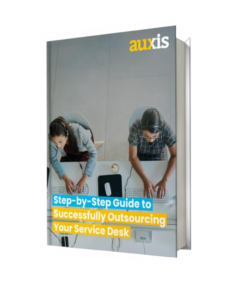In brief:
- AI automation is essential to creating a responsive, efficient, and well-structured help desk – improving business outcomes, employee productivity, and end-user experiences.
- Service desk automation benefits include faster issue resolution, enhanced efficiencies, lower costs, and around-the-clock availability.
- Top opportunities for leveraging service desk automation tools include knowledge base management, self-service channels, quality assurance, workflow automation, and data analytics.
In today’s fast-paced business world, failing to establish a responsive and efficient IT service desk can have serious consequences for organizations – about 98% say just one hour of downtime can cost more than $100,000. AI-powered IT service desk automation can transform your help desk service delivery – speeding response and resolution without sacrificing quality by reducing manual effort on time-consuming, repetitive activities.
This blog explores how service desk automation can alleviate the challenges plaguing help desks, such as high ticket volumes, slow response times, repetitive tasks, inconsistent service quality, etc. We also spotlight key areas where IT service desk automation can deliver the most benefits.
Why is IT help desk automation so important?
Today, outdated help desks are often the biggest stumbling block for organizations striving for IT operational efficiency, providing slow and inadequate resolutions that impact business continuity. End users lose an average of 3 hours 12 minutes of working time due to IT incidents, HappySignals’ latest Global IT Experience Benchmark Report found.
The report also found a strong correlation between ticket bouncing/reassignment and lowered productivity – when a ticket is reassigned four times, it can result in a total loss of 9 hours and 8 minutes of working time!

The IT help desk’s struggles are not new. Many help desks find themselves stuck in firefighting mode, struggling to keep pace with an unprecedented number of requests at extended hours. Service desk teams are supporting an ever-widening range of new technologies – while tightening budgets and mounting pressure for IT to add strategic value make it difficult for technical resources to devote enough attention to support.
Recruiting and retaining help desk talent amid the persistent tech labor shortage presents another significant challenge to consistent and timely support, with help desks in the U.S. seeing high turnover rates averaging 42%.
From a cost perspective too, running a manual process-heavy service desk is no longer feasible. Cost per ticket increases proportionally with ticket handle time – thus, in a labor-intensive function, more hours of work on a ticket means a corresponding increase in costs.
Depending on the geographic location of your service desk, a 10-minute ticket could cost anywhere between $10-$25, according to the Help Desk Institute.

Service desk automation is imperative to alleviating service desk pain points and preventing IT departments from falling behind and impeding the business goals of the larger organization.
10 key service desk automation benefits
IT service desk automation provides multiple benefits to users, IT teams, and the entire organization.
1. Faster issue resolution
Automation enables quicker identification and resolution of common IT issues, reducing downtime. The HappySignals report found 69% of tickets can be resolved by automation, spanning simple requests like password resets with low impact on end-user productivity.
2. Enhanced efficiency
Automating repetitive tasks such as software installation streamlines workflows, allowing IT teams to focus on complex problems.
3. Cost savings
By minimizing manual effort, automation reduces labor costs and optimizes resource allocation.
4. Improved user experience
Automated self-service options and faster support responses improve customer satisfaction. 69% of people prefer to attempt to solve issues on their own before reaching out to support, Zendesk’s 2025 CX Trends report found.
5. Round-the-clock availability
Organizations in industries like restaurants and retail require support beyond regular hours. Service desk automation systems can go a long way in providing cost-effective 24/7 support.
6. Reduced errors
Automation eliminates human errors in repetitive tasks, improving service reliability.
7. Better resource management
Automating ticket triaging and prioritization ensures optimal use of IT resources.
8. Scalable support
Automation easily scales to accommodate increased support demands during peak periods.
9. Proactive issue detection
Automated monitoring tools identify and address potential issues before they escalate.
10. Data-driven insights
Automation collects and analyzes data to provide actionable insights for continuous improvement.
3 key opportunities for service desk automation
The biggest opportunities for implementing IT help desk automation lie in the following areas:
1. Knowledge base management
Comprehensive, well-maintained IT knowledge bases are key to providing effective self-service options. IT knowledge bases underpin Level 0 self-service tools such as chatbots, searchable databases, and self-service portals.
Automation plays a crucial role in keeping knowledge bases updated, ensuring that users have access to relevant and reliable information. AI enhances this by enabling intelligent search, context-aware recommendations, and proactive content updates based on user queries and feedback – creating a more dynamic and responsive system that improves satisfaction and reduces service desk workloads by helping users quickly find relevant information.
A dedicated knowledge management portal helps reduce agents’ time spent on ticket resolution by 2.19 hours, the 2024 Freshservice Service Management Benchmark Report found.
2. Human-like chatbots
Generative AI-powered chatbots take this a step further, serving as virtual support agents which understand and respond to common inquiries in a more human-like manner and offer immediate support – a far cry from the rigid, scripted responses of traditional chatbots.
This GenAI-powered self-service is helping IT teams provide quick resolutions to recurring issues, while also independently resolving more than half (53%) of tickets raised, the 2024 Freshservice report found.

Auxis has embraced this innovation through its proprietary AI-powered chatbot, Auxis Connect, which integrates animated knowledge bases to revolutionize how users interact with IT support. Below are the steps the Auxis Connect bot follows to provide issue or incident resolution:
- When a user connects to Auxis Connect and reports an incident, the bot automatically searches through a knowledge base of videos providing resolutions to common IT problems. These videos provide clear, step-by-step guidance, enabling users to address their issues independently.
- If the bot cannot find an appropriate video or knowledge article, it seamlessly connects with ChatGPT, which generates a detailed, step-by-step solution. This allows users to attempt self-resolution.
- Only when these resources are insufficient does the bot escalate the issue and connect the user with a human agent, ensuring that all possible self-service avenues have been exhausted first.
- Instead of merely responding to user queries, the bot also anticipates potential issues by suggesting relevant articles or videos as soon as the incident is reported, helping reduce the time users spend searching for solutions and increasing the likelihood of a quick resolution, ultimately minimizing downtime.
Auxis Connect is a prime example of how AI-driven technology can empower users, streamline support processes, and free up agents to focus on high-value, complex tasks – fostering a high-performing, empowered workforce.
3. Quality assurance
Quality Assurance (QA) is essential to service desks, ensuring the service provided meets customer expectations and agreed-upon standards. Some important ways of measuring and improving QA are through call and ticket monitoring, review, feedback, and coaching.
QA is becoming an even bigger focus as high-quality service desk providers combine service-level agreements (SLAs) with experience-level agreements (XLAs), shifting the emphasis from merely meeting metrics to achieving high levels of customer satisfaction. Today, 45% of RFPs have XLAs as a key ask, according to a 2023 Everest Group survey, while the number of engagements featuring XLAs as contractual commitments increased by 35%.
QA efforts can directly support XLAs by monitoring and improving how well a service desk delivers positive user experiences – addressing issues like communication quality, problem resolution, and overall user satisfaction.
Yet, performing QA manually is incredibly time-consuming and prone to inconsistencies, as it requires thorough review and analysis of tickets, interactions, and resolutions. The average support team can only review 2-5% of its conversations manually, according to analysis by Zendesk’s Klaus.
The larger the ticket volume, the harder it is to achieve even that proportion.
Today, AI-assisted automation is playing a big part in helping ease the pain points of the QA process – automating selection of conversations to review, identifying key interactions based on sentiment or keywords, flagging patterns or anomalies that might be missed in manual reviews, and prioritizing critical issues for evaluation.
Auxis’ QA automation, developed in-house, enables the Auxis Center of Excellence to significantly surpass the industry standard of 5% by automatically analyzing 80% of our monthly service desk agent volume. The automation enables thousands of tickets to be reviewed against predefined criteria, examining if they have all the required information, correct priority levels, a closing comment from the agent, etc.
After the automation assigns a score and recommendations, consolidated results are shared with service desk team leads, who use them as the foundation for coaching agents.
The result of Auxis’ innovation:
- 100% ticket evaluation for QA.
- Instant analysis, with automation providing insights within a few minutes for each service desk call.
- More consistent service and continuous improvement of service quality, enabled by standardized and faster feedback.
Other top AI automation opportunities to consider
Predictive analytics
AI can help analyze data patterns and predict potential issues, enabling help desk teams to proactively address problems and minimize service disruptions. It can also analyze past interactions and preferences to tailor support for customers.
Intelligent automation of service desk processes
Intelligent automation can significantly improve the operational efficiency of service desk processes. For example, routing tickets to the right agents and prioritizing requests, personalizing interactions, and surfacing relevant information in real time for agents based on user inquiries.
Gain instant access to exceptional IT service desk automation with the right provider
IT service desk automation helps transform your support team into a high-performing help desk. However, IT departments consumed with other priorities often lack the time or expertise to choose, implement, and maintain the right help desk automation tools.
Outsourcing your service desk to a high-quality provider delivers instant access to the process maturity, automation tools, resources, talent, and proactive approach that ensure top-quality support.
Today, help desk is one of the most outsourced IT functions, with 50% of IT organizations outsourcing service desk operations, according to Computer Economics’ 2023 IT Outsourcing Statistics report. More than half (55%) of help desk and desktop support processes are currently outsourced – the highest percentage of all IT functions.
Even more telling, 91% of organizations that outsource their help desk expect to increase or retain their investment, the report found.
Selecting a reliable help desk nearshoring partner like Auxis is key to elevating your help desk to a modern, service-centric operation. Combining custom solutions with nearshore advantages like real-time communication and lower turnover, Auxis is firmly on the path to building an automation-first IT practice which helps our clients resolve issues faster, stand firmly against cyberthreats, and ensure IT infrastructure works as expected – helping IT fulfill its promise of serving as a business-enablement powerhouse for its organization.
Want to learn more about how service desk automation can benefit your business goals? Schedule a consultation with our help desk leaders today! Or visit our resource center to learn more help desk trends, strategies, and success stories.




